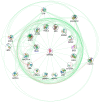Discovery of GLO1 New Related Genes and Pathways by RNA-Seq on A2E-Stressed Retinal Epithelial Cells Could Improve Knowledge on Retinitis Pigmentosa
- PMID: 32413970
- PMCID: PMC7278727
- DOI: 10.3390/antiox9050416
Discovery of GLO1 New Related Genes and Pathways by RNA-Seq on A2E-Stressed Retinal Epithelial Cells Could Improve Knowledge on Retinitis Pigmentosa
Abstract
Endogenous antioxidants protect cells from reactive oxygen species (ROS)-related deleterious effects, and an imbalance in the oxidant/antioxidant systems generates oxidative stress. Glyoxalase 1 (GLO1) is a ubiquitous cellular enzyme involved in detoxification of methylglyoxal (MG), a cytotoxic byproduct of glycolysis whose excess can produce oxidative stress. In retinitis pigmentosa, one of the most diffuse cause of blindness, oxidative damage leads to photoreceptor death. To clarify the role of GLO1 in retinitis pigmentosa onset and progression, we treated human retinal pigment epithelium cells by the oxidant agent A2E. Transcriptome profiles between treated and untreated cells were performed by RNA-Seq, considering two time points (3 and 6 h), after the basal one. The exposure to A2E highlighted significant expression differences and splicing events in 370 GLO1 first-neighbor genes, and 23 of them emerged from pathway clustered analysis as main candidates to be associated with retinitis pigmentosa. Such a hypothesis was corroborated by the involvement of previously analyzed genes in specific cellular activities related to oxidative stress, such as glyoxylate and dicarboxylate metabolism, glycolysis, axo-dendritic transport, lipoprotein activity and metabolism, SUMOylation and retrograde transport at the trans-Golgi network. Our findings could be the starting point to explore unclear molecular mechanisms involved in retinitis pigmentosa etiopathogenesis.
Keywords: A2E; GLO1; RNA-Seq; oxidative stress; retinitis pigmentosa.
Conflict of interest statement
The authors declare no conflict of interest.
Figures



References
-
- Groener J.B., Oikonomou D., Cheko R., Kender Z., Zemva J., Kihm L., Muckenthaler M., Peters V., Fleming T., Kopf S., et al. Methylglyoxal and Advanced Glycation End Products in Patients with Diabetes—What We Know so Far and the Missing Links. Exp. Clin. Endocrinol. Diabetes. 2019;127:497–504. doi: 10.1055/s-0043-106443. - DOI - PubMed
LinkOut - more resources
Full Text Sources
Research Materials
Miscellaneous

